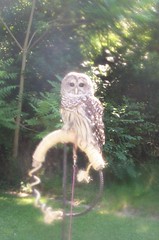HABITAT
The barred owl, (strix varia) is an owl of deep forests, swamps and woodlands near waterways. Their range covers much of North America except for the Rocky Mountains and the deserts of the Southwest. Their range slightly overlaps the range of the Spotted Owl, and there is evidence that in some areas as they push west, they are pushing the spotted owl out. Northern populations can be migratory, depending on food sources.
Territories can be between 200 and 900 acres.
PHYSICAL DESCRIPTION
They are medium-sized owls , and like most other raptors, are sexually dimorphic only in size. The males are approximately 16-20 inches in length, and weigh about a pound.
Females are much longer at 20-25 inches, and weigh around a pound and a half.
Stumbling across an owl is always a surprise and pleasure, and when they are flying away, they always seem larger than they actually are. I've heard many a tale from folks who say, "This owl came flying out of a tree and it was this big! (holding out both arms)".
The barred owl is our only medium to large owl with dark eyes. They have no ear tufts.
They are called "barred" because of the pattern of their plumage...white, brown and gray bars.
VOICE
Barred owls are my favorite birds to listen to...a very distinctive hooting, which is phrased as
"Who cooks for-you, who cooks for-you all?"
Click HERE to listen to the typical call.
They can also caw, scream, caterwaul and grunt like monkeys.
HUNTING AND FOOD
Like all birds, barred owls are opportunistic. Not strictly nocturnal, they can be seen hunting before sunset, usually on cloudy cold days, or during nesting season. They use a perch from which to dive down to its prey (meadow voles, mice, rats, mink [that's ironic, given that Elvis was killed by one] frogs, snakes, fish (wading into the water for them), small birds, large insects, squirrels...you get the idea.)
REPRODUCTION
Barred owls call throughout the year, but things really get turned up starting in February when they go looking for love. Breeding starts in March. They do not construct a nest, but use tree cavities and will also use nest boxes. An abandoned hawk or crow nest can also be used.
The female will lay 2-4 eggs, one every 2 days or so. Incubation begins with the first egg, so the eggs will be staggered as they hatch 28-33 days later, and they will fledge in 42 days.
Barred owl parents will care for their young for 4 months, much longer than other owls.
The young, when they are grown, will not go far from their birthplace, usually staying within 6 miles. Pairs mate for life and a nest site will be used for many years.
LIFE SPAN
Barred owls can live in the wild for 10 years, and in captivity, up to 23 years. Their only natural enemies are great horned owls.

"Thank you, thank you very much."


5 comments:
Susan, I am digging the Owl Pages. Thanks!
Are you and your kin fully recovered?
Susan, I've asked this question many times but have never gotten an answer- Do you know why different owl species have different colored eyes? Does it have anything to do with when or what they hunt? Why wouldn't they have evolved with all the same color eyes?
Please- I NEED to know!!!
"My" barred owl has been eating shrews (and some mousey/voley little rodents)
Piles of little bones! Pretty cool.
I am shocked at their life span and that owls are predators of other owls...
AWESOME post. Your really know how to learn us.
Of the owls I've heard. I love to listen to the call of the Western Screech Owl. Its so soothing to be sung to sleep in the pine. Its so cool to see owls. I've always wondered why they have such a bad rep with Native Americans (In the west at least).
Post a Comment